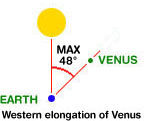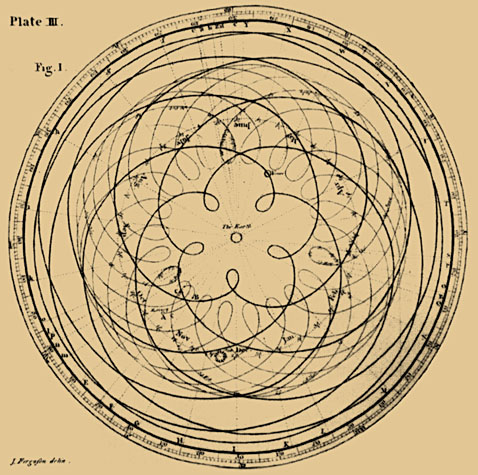The pentagram (pentacle or pentalpha) is considered by some western occultists to trace its esoteric significance to an astronomical observance of the pattern of Venus' conjunctions with the Sun. This is not possible.
 A superior conjunction occurs when Venus is behind the Sun and the inferior conjunction is when Venus is between Earth and the Sun; in both cases Venus is not visible. But it is true that plotting the recurrence of Venus' westward elongation from the Sun, over five consecutive synodic periods, will create the points of a pentagram. This period is approximately 584 days long, each period determining a different point of the observed pentagram—taking approximately eight years, five days to complete the figure. One would get a pentagram by picking any sunrise date on which the morning star is prominent and then repeating the observation at 584 day intervals following that date.
The synodic period of Venus, the time required for it to return to the same position relative to the Sun as seen by an observer on Earth, is 583.9211 days. There is a 0.0789 day slippage every 584 days, totalling a one day slippage each 12.67 synodic periods. This means that the pentagram figure is slowly revolving within an oval in a clockwise direction, alternating either one or two points ascendant roughly every 160 years. There is no observation point on Earth that would present a regular pentagram. Moving further north elongates the figure while on the equator the figure is an irregular pentagon.
Compiled by Trevor W. McKeown. Calculations and text reviewed by Dr. Leigh Hunt Palmer. A superior conjunction occurs when Venus is behind the Sun and the inferior conjunction is when Venus is between Earth and the Sun; in both cases Venus is not visible. But it is true that plotting the recurrence of Venus' westward elongation from the Sun, over five consecutive synodic periods, will create the points of a pentagram. This period is approximately 584 days long, each period determining a different point of the observed pentagram—taking approximately eight years, five days to complete the figure. One would get a pentagram by picking any sunrise date on which the morning star is prominent and then repeating the observation at 584 day intervals following that date.
The synodic period of Venus, the time required for it to return to the same position relative to the Sun as seen by an observer on Earth, is 583.9211 days. There is a 0.0789 day slippage every 584 days, totalling a one day slippage each 12.67 synodic periods. This means that the pentagram figure is slowly revolving within an oval in a clockwise direction, alternating either one or two points ascendant roughly every 160 years. There is no observation point on Earth that would present a regular pentagram. Moving further north elongates the figure while on the equator the figure is an irregular pentagon.
Compiled by Trevor W. McKeown. Calculations and text reviewed by Dr. Leigh Hunt Palmer.
| |

|
Above: Plotting the apparent position of Venus in altitude and azimuth as observed from Uruk (Lat. 31°19'00") at the moment of sunrise for consecutive apparitions separated by intervals of 584 days, starting at sunrise, 06:12:07 am, March 23, 716BCE, during the reign of Tiglath-pileser III, near the times of greatest westward elongation of the planet (46.070° - 46.3620°). The Julian Period is noted. The moving light on the horizon is the sun as east is fixed and the seasons vary.
A plotting taken for similar periods running from, or to, January 13, 2003 would show a pentagram with one point down. These figures are not readily available in published form but can be created using software applications such as Starry Night.
Note that Venus is not travelling in a straight line from point to point. The lines are a construct determined by the observer. Any running set of observation times other than those tied to the synodic period of Venus would create a recursive pattern such as that shown below.
|
|

